The Intel 9th Gen Review: Core i9-9900K, Core i7-9700K and Core i5-9600K Tested
by Ian Cutress on October 19, 2018 9:00 AM EST- Posted in
- CPUs
- Intel
- Coffee Lake
- 14++
- Core 9th Gen
- Core-S
- i9-9900K
- i7-9700K
- i5-9600K
CPU Performance: System Tests
Our System Test section focuses significantly on real-world testing, user experience, with a slight nod to throughput. In this section we cover application loading time, image processing, simple scientific physics, emulation, neural simulation, optimized compute, and 3D model development, with a combination of readily available and custom software. For some of these tests, the bigger suites such as PCMark do cover them (we publish those values in our office section), although multiple perspectives is always beneficial. In all our tests we will explain in-depth what is being tested, and how we are testing.
All of our benchmark results can also be found in our benchmark engine, Bench.
Application Load: GIMP 2.10.4
One of the most important aspects about user experience and workflow is how fast does a system respond. A good test of this is to see how long it takes for an application to load. Most applications these days, when on an SSD, load fairly instantly, however some office tools require asset pre-loading before being available. Most operating systems employ caching as well, so when certain software is loaded repeatedly (web browser, office tools), then can be initialized much quicker.
In our last suite, we tested how long it took to load a large PDF in Adobe Acrobat. Unfortunately this test was a nightmare to program for, and didn’t transfer over to Win10 RS3 easily. In the meantime we discovered an application that can automate this test, and we put it up against GIMP, a popular free open-source online photo editing tool, and the major alternative to Adobe Photoshop. We set it to load a large 50MB design template, and perform the load 10 times with 10 seconds in-between each. Due to caching, the first 3-5 results are often slower than the rest, and time to cache can be inconsistent, we take the average of the last five results to show CPU processing on cached loading.
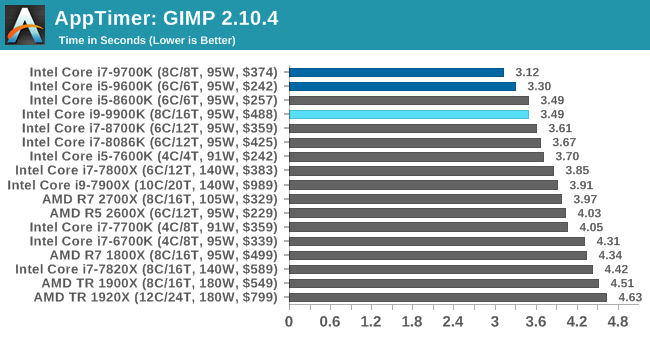
Application loading is typically single thread limited, but we see here that at some point it also becomes core-resource limited. Having access to more resources per thread in a non-HT environment helps the 8C/8T and 6C/6T processors get ahead of both of the 5.0 GHz parts in our testing.
FCAT: Image Processing
The FCAT software was developed to help detect microstuttering, dropped frames, and run frames in graphics benchmarks when two accelerators were paired together to render a scene. Due to game engines and graphics drivers, not all GPU combinations performed ideally, which led to this software fixing colors to each rendered frame and dynamic raw recording of the data using a video capture device.
The FCAT software takes that recorded video, which in our case is 90 seconds of a 1440p run of Rise of the Tomb Raider, and processes that color data into frame time data so the system can plot an ‘observed’ frame rate, and correlate that to the power consumption of the accelerators. This test, by virtue of how quickly it was put together, is single threaded. We run the process and report the time to completion.
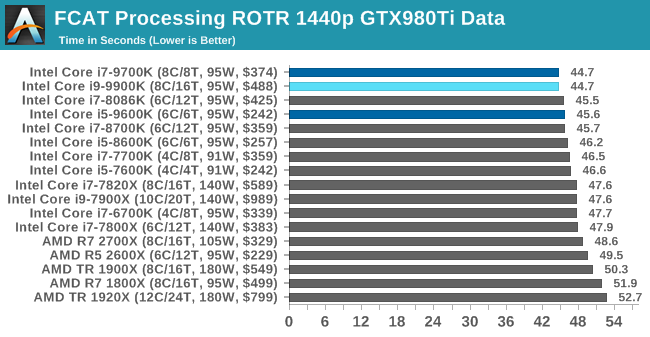
FCAT is another single thread limited scenario, and it looks like the new 9th gen parts do very well here. The 9700K and 9900K get the same time, split by milliseconds.
3D Particle Movement v2.1: Brownian Motion
Our 3DPM test is a custom built benchmark designed to simulate six different particle movement algorithms of points in a 3D space. The algorithms were developed as part of my PhD., and while ultimately perform best on a GPU, provide a good idea on how instruction streams are interpreted by different microarchitectures.
A key part of the algorithms is the random number generation – we use relatively fast generation which ends up implementing dependency chains in the code. The upgrade over the naïve first version of this code solved for false sharing in the caches, a major bottleneck. We are also looking at AVX2 and AVX512 versions of this benchmark for future reviews.
For this test, we run a stock particle set over the six algorithms for 20 seconds apiece, with 10 second pauses, and report the total rate of particle movement, in millions of operations (movements) per second. We have a non-AVX version and an AVX version, with the latter implementing AVX512 and AVX2 where possible.
3DPM v2.1 can be downloaded from our server: 3DPMv2.1.rar (13.0 MB)
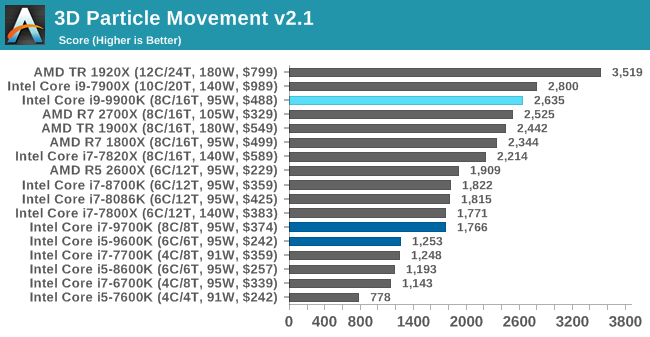
With a non-AVX code base, the 9900K shows the IPC and frequency improvements over the R7 2700X, although in reality it is not as big of a percentage jump as you might imagine. The processors without HT get pushed back a bit here.
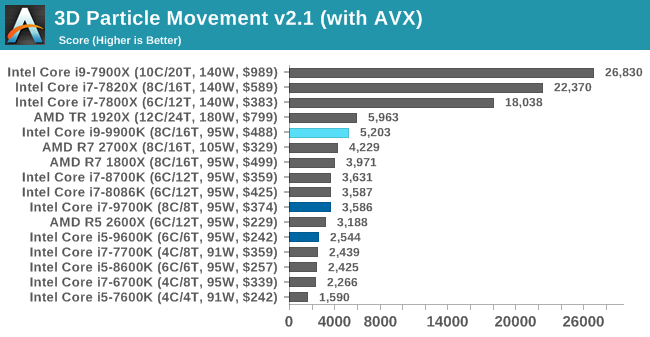
When we factor in AVX2/AVX512, the Skylake-X processors go off into a world of their own. The 9900K gets a bigger jump on the R7 2700X, more in line with what we expect, and the Core i7-9700K gets a boost as well.
Dolphin 5.0: Console Emulation
One of the popular requested tests in our suite is to do with console emulation. Being able to pick up a game from an older system and run it as expected depends on the overhead of the emulator: it takes a significantly more powerful x86 system to be able to accurately emulate an older non-x86 console, especially if code for that console was made to abuse certain physical bugs in the hardware.
For our test, we use the popular Dolphin emulation software, and run a compute project through it to determine how close to a standard console system our processors can emulate. In this test, a Nintendo Wii would take around 1050 seconds.
The latest version of Dolphin can be downloaded from https://dolphin-emu.org/
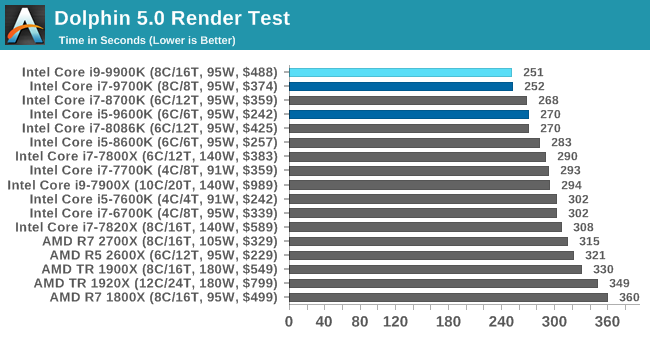
Dolphin is another single thread limited scenario, wher Intel processors have historically done well. Here the 9900K nudges out the 9700K by a second.
DigiCortex 1.20: Sea Slug Brain Simulation
This benchmark was originally designed for simulation and visualization of neuron and synapse activity, as is commonly found in the brain. The software comes with a variety of benchmark modes, and we take the small benchmark which runs a 32k neuron / 1.8B synapse simulation, equivalent to a Sea Slug.
Example of a 2.1B neuron simulation
We report the results as the ability to simulate the data as a fraction of real-time, so anything above a ‘one’ is suitable for real-time work. Out of the two modes, a ‘non-firing’ mode which is DRAM heavy and a ‘firing’ mode which has CPU work, we choose the latter. Despite this, the benchmark is still affected by DRAM speed a fair amount.
DigiCortex can be downloaded from http://www.digicortex.net/
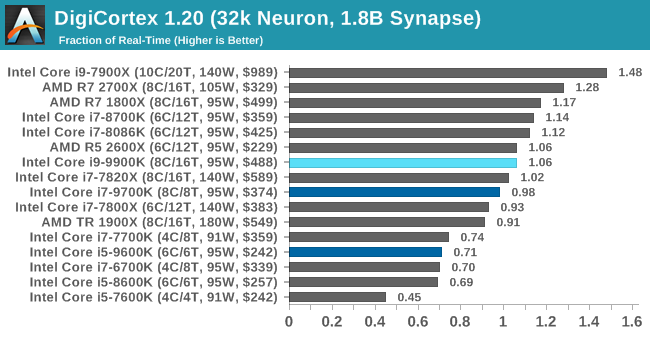
DigiCortex runs high on CPU performance and memory bandwidth, but it seems here that a 6-core Ryzen can match the 8-core 9900K pretty easily. the 8700K/8086K seem to do better on this test as well.
y-Cruncher v0.7.6: Microarchitecture Optimized Compute
I’ve known about y-Cruncher for a while, as a tool to help compute various mathematical constants, but it wasn’t until I began talking with its developer, Alex Yee, a researcher from NWU and now software optimization developer, that I realized that he has optimized the software like crazy to get the best performance. Naturally, any simulation that can take 20+ days can benefit from a 1% performance increase! Alex started y-cruncher as a high-school project, but it is now at a state where Alex is keeping it up to date to take advantage of the latest instruction sets before they are even made available in hardware.
For our test we run y-cruncher v0.7.6 through all the different optimized variants of the binary, single threaded and multi-threaded, including the AVX-512 optimized binaries. The test is to calculate 250m digits of Pi, and we use the single threaded and multi-threaded versions of this test.
Users can download y-cruncher from Alex’s website: http://www.numberworld.org/y-cruncher/
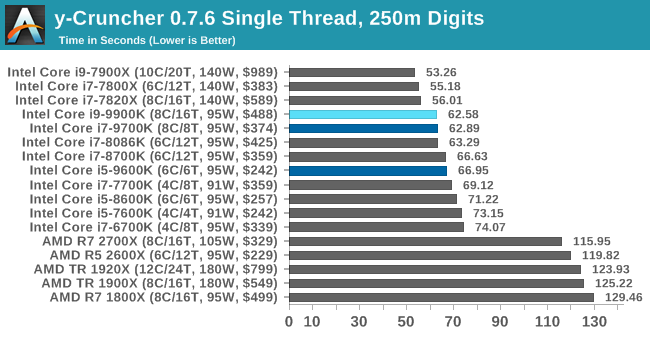
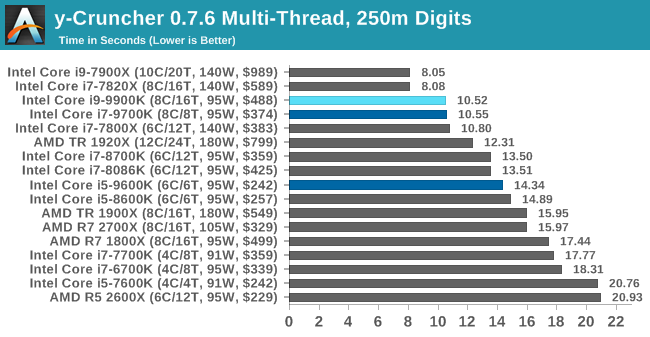
As y-cruncher has AVX2/AVX512 benefits, we see the Skylake-X processors again go off in their own little world. In multi-threaded, it takes 8 cores in the 9900K/9700K to get beyond a 6-core AVX512 enabled part.
Agisoft Photoscan 1.3.3: 2D Image to 3D Model Conversion
One of the ISVs that we have worked with for a number of years is Agisoft, who develop software called PhotoScan that transforms a number of 2D images into a 3D model. This is an important tool in model development and archiving, and relies on a number of single threaded and multi-threaded algorithms to go from one side of the computation to the other.
In our test, we take v1.3.3 of the software with a good sized data set of 84 x 18 megapixel photos and push it through a reasonably fast variant of the algorithms, but is still more stringent than our 2017 test. We report the total time to complete the process.
Agisoft’s Photoscan website can be found here: http://www.agisoft.com/
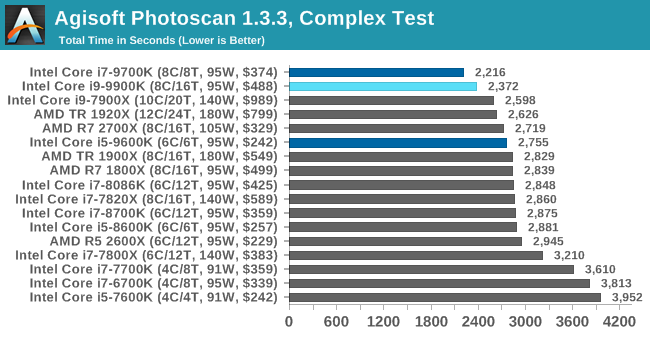
Photoscan is a task that seems to enjoy both high throughput, single threaded performance, and in this case it looks like having HT off as well.


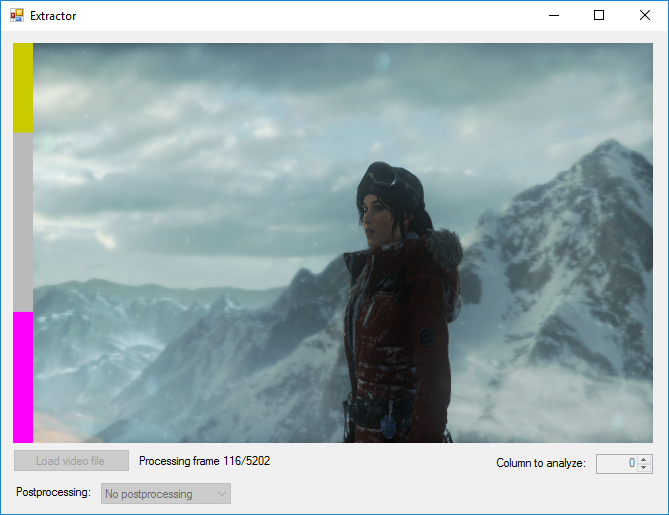

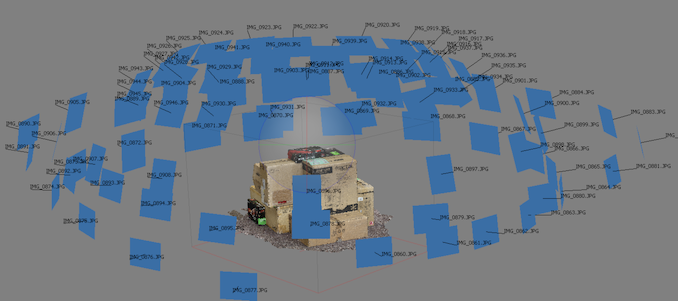








274 Comments
View All Comments
leexgx - Saturday, October 20, 2018 - link
Can you please stop your website playing silent audio, very annoying as it stops playback on my other phone (dual connection headset)moozooh - Sunday, October 21, 2018 - link
To be fair, the 9900K seems like a suboptimal choice for a gaming rig despite the claims—the extra performance is marginal and comes at a very heavy price. Consider that in all the CPU-bound 95th percentile graphs (which are the only important ones in this context)—even in the more CPU-intensive games—the 9700K was within 5% of the 9900K, sometimes noticeably faster (e.g. Civ6 Low). And its overclocking potential is just *so* much better—all of this at ~3/4 the price and power consumption (and hence more relaxed cooling requirements and lower noise). I cannot possibly envision a scenario where a rational choice, all this considered, would point to 9900K for a gaming machine. The at most 5% extra performance just isn't worth the downsides.On a sidenote, I'd actually like to see how an overclocked 9700K fares against overclocked 8700K/8086K (delidded for fair comparison—you seem to have had at least one of those, no?) with regards to frame times/worst performance. For my current home PC I chose a delidded 8350K running at 4.9 GHz on 1–2 cores and at 4.7 GHz on 3–4, which I considered the optimal choice for my typical usage, where the emphasis lies on non-RTS games, general/web/office performance, emulation, demoscene, some Avisynth—basically all of the tasks that heavily favor per-thread performance and don't scale well with HT. In most of the gaming tests the OC 8350K showed frame times about on par with the twice more expensive 8700K at stock settings, so it made perfect sense as a mid-tier gaming CPU. It appears that 9700K would be an optimal and safe drop-in replacement for it as it would double the number of cores while enabling even better per-thread performance without putting too much strain on the cooler. But then again I'd be probably better off waiting for its Ice Lake counterpart with full (?) hardware Spectre mitigation, which should result in a "free" minor performance bump if nothing else. At least assuming it will still use the same socket, which you never can tell with Intel...
R0H1T - Sunday, October 21, 2018 - link
Ryan & Ian, I see that the last few pages have included a note about Z390 used because the Z370 board was over-volting the chip? Yet on the Overclocking page we see the Z370 listed with max CPU package power at 168 Watts? Could you list the (default) auto voltage applied by the Asrock Z370 & if appropriate update the charts on OCing page with the Z390 as well?Total Meltdowner - Sunday, October 21, 2018 - link
Ryan, you do great work. Please don't let all these haters in the comments who constantly berate you over grammar and typos get you down.Icehawk - Saturday, October 27, 2018 - link
Ryan, I still haven't been able to find an answer to this - what are your actual HEVC settings? Because I've got an 8700 @4.5 no offset and it does 1080p at "1080p60 HEVC at 3500 kbps variable bit rate, fast setting, main profile" with passthrough audio and I get ~40fps not the 175 you achieved - how on earth are you getting over 4x the performance??? The only way I can get remotely close would be to use NVENC or QuickSync neither of which are acceptable to me.phinnvr6@gmail.com - Wednesday, October 31, 2018 - link
My thoughts are why would anyone recommend the 9900K over the 9700K? It's absurdly priced, draws an insane amount of power, and performs roughly identical.DanNeely - Friday, October 19, 2018 - link
Have any mobo makers published block diagrams for their Z390 boards? I'm wondering if the 10GB USB3.1 ports are using 2 HSIO lanes as speculated in the mobo preview article, or if Intel has 6 lanes that can run at 10gbps instead of the normal 8 so that they only need one lane each.repoman27 - Friday, October 19, 2018 - link
They absolutely do not use 2 HSIO lanes. That was a total brain fart in the other article. The datasheet for the other 300 series chipsets is available on ARK, and the HSIO configuration of the Z390 can easily be extrapolated from that.HSIO lanes are just external connections to differential signaling pairs that are connected internally to either various controllers or a PCIe switch via muxes. They’re analog interfaces connected to PHYs. They operate at whatever signaling rate and encoding scheme the selected PHY operates at. There is no logic to perform any type of channel bonding between the PCH and any connected ports or devices.
TEAMSWITCHER - Friday, October 19, 2018 - link
My big question ... Could there be an 8 core Mobile part on the way?Ryan Smith - Friday, October 19, 2018 - link
We don't have it plotted since we haven't taken enough samples for a good graph, but CFL-R is showing a pretty steep power/frequency curve towards the tail-end. That means power consumption drops by a lot just by backing off of the frequency a little.So while it's still more power-hungry than the 6-cores at the same frequencies, it's not out of the realm of possibility. Though base clocks (which are TDP guaranteed) will almost certainly have to drop to compensate.